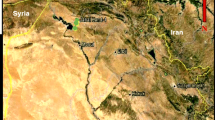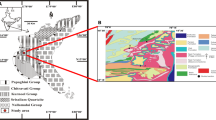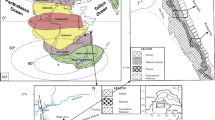Abstract
The enormously thick sedimentary succession exposed between Rishabhdev Lineament and rocks of the Delhi Supergroup constitutes Jharol Formation of the Aravalli Supergroup in Udaipur region of Rajasthan. The whole sedimentary succession is named Jharol Formation and designated as deep water turbidites. A detailed field examination indicates presence of two distinctly different litho successions juxtaposed across a crustal level fault along which brecciated ultramafics are tectonically emplaced. The sedimentary successions exposed immediate west of the Rishabhdev Lineament are deep water sediments with distinct facies types characterizing inner to outer lobe stacked turbidites. These turbidites are similar to the turbidites of the Udaipur Formation and Tidi Formation exposed east of the Rishabhdev Lineament. However, the sedimentary succession exposed west of these deep water sediments across the aforesaid fault contains facies types that represent continental to shallow marine deposits. This basin marginal sediments continue up to the contact with rocks of the Delhi Supergroup. Such litho-association suggests that a separate formation status of the sediments lying west of the Rishabhdev Lineament should be dropped and the turbidites of the Udaipur Formation should be considered as the youngest formation of the Aravalli Supergroup.






Similar content being viewed by others
References
Banerjee D M and Bhattacharya P 1989 Petrofacies analysis of the clastic rocks in the Proterozoic Aravalli basin, Udaipur district, south central Rajasthan; Indian Miner. 43(3/4) 194–225.
Banerjee D M and Bhattacharya P 1994 Petrology and geochemistry of greywackes from the Aravalli Supergroup Rajasthan, India and the tectonic evolution of a Proterozoic sedimentary basin; Precamb. Res. 67 11–35.
Bhattacharya H N 1991 A reappraisal of the depositional environment of the Precambrian metasediments around Ghatsila–Galudih, Eastern Singhbhum; J. Geol. Soc. India 37 47–54.
Bhattacharya H N 2014a Tectonic control on sedimentation and related Pb–Zn sulphide mineralization in Aravalli Super Group, Rajasthan, India; Int. Assoc. Gond. Res. Conf. Series 18 105–151.
Bhattacharya H N 2014b Outer marginal post-rift collapse along the north-western fringe of Indian Shield – evolution of a Paleoproterozoic continental passive margin; 19th International Sedimentological Congress, Jeneva, Switzerland, Abstract vol., p. 73.
Bhattacharya H N and Bhattacharya B 2005 Storm event beds in a Paleoproterozoic rift basin, Aravalli Supergroup, Rajasthan India; Gond. Res. 8(2) 231–239.
Bhattacharya H N and Bull S 2010 Tectono-sedimentary setting of the Paleoproterozoic Zawar Pb–Zn deposits, Rajasthan, India; Precamb. Res. 177 323–338.
Daele M V, Meye I, Moernaut J, Decker S D, Verschuren D and Batist M 2017 A revised classification and terminology for stacked and amalgamated turbidites in environments dominated by (hemi) pelagic sedimentation; Sedim. Geol. 357 72–82.
Einsele G 2000 Sedimentary basins; Springer-Verlag, New York, 792p.
Fetter M, De Ros L and Bruhn C H L 2009 Petrographic and seismic evidence for the depositional setting of giant turbidite reservoirs and the paleogeographic evolution of Campos Basin, offshore Brazil; Mar. Petrol. Geol. 26 824–853.
Gupta S N, Arora Y K, Mathur R K, Iqballuddin, Prasad B, Sahai T N and Sharma S B 1997 Precambrian geology of the Aravalli region, southern Rajasthan and northeastern Gujarat; Geol. Surv. India Memoir 123 262.
Hansen L, Callow R, Kane I and Kneller B 2017 Differentiating submarine channel-related thin-bedded turbidite facies: Outcrop examples from the Rosario Formation, Mexico; Sedim. Geol. 358 19–34.
Hodgson D M 2009 Distribution and origin of hybrid beds in sand-rich submarine fans of the Tanqua depocentre, Karoo Basin, South Africa; In: Hybrid and Transitional Submarine Flows (eds) Amy L A, McCaffrey W B and Talling P J, Mar. Petrol. Geol. 26 1940–1957.
Kane I and Hodgson D M 2011 Sedimentological criteria to differentiate submarine channel levee sub-environments: Exhumed examples from the Rosario Fm. (Upper Cretaceous) of Baja California, Mexico, and the Fort Brown Fm. (Permian), Karoo Basin, S. Africa; Mar. Petrol. Geol. 28 807–823.
Lowe D R 1982 Sediment gravity flows; II. Depositional models with special reference to the deposits of high-density turbidity currents; J. Sediment. Res. 52(1) 279–297.
Mutti E, Bernouli D, Ricci Lucchi F and Tinterri R 2009 Turbidites and turbidity currents from Alpine ‘flysch’ to the exploration of continental margins, Sedimentology 56 267–318.
Pindell J, Graham R and Horn B 2014 Rapid outer marginal collapse at the rift to drift transition of passive margin evolution, with a Gulf of Mexico case study; Basin Research 26 701–725.
Poddar B C and Mathur R K 1965 A note on repetitious sequence of greywacke–slate–phyllite in the Aravalli system around Udaipur, Rajasthan; Bull. Geol. Soc. India 2 84–88.
Podder B C 1966 An example of contrasted tectonic regimes from Precambrians of Udaipur district, Rajasthan; Indian Min. 20 192–194.
Roy A B 1988 Stratigraphic and tectonic framework of Aravalli mountain range, Precambrian of the Aravalli mountain; In: Precambrian of the Aravalli Mountain, Rajasthan, India (ed.) Roy A B, Geol. Soc. India Memoir 7 3–31.
Roy A B and Paliwal B S 1981 Evolution of lower Proterozoic Epicontinental deposits: stromatolite bearing Aravalli rocks of Udaipur, Rajasthan, India; Precamb. Res. 14 49–74.
Roy A B and Jakhar S 2002 Geology of Rajasthan (Northwest India), Precambrian to Recent; Scientific Publishers (India).
Roy A B and Purohit R 2018 Indian shield – Precambrian evolution and phanerozoic reconstruction; Elsevier, Netherlands.
Roy A B, Paliwal B S, Shekhawat S S, Nagori D K, Golani P R and Bejarniya B R 1988 Stratigraphy of the Aravalli Supergroup in the type area. A Precambrian of the Aravalli Mountain, Rajasthan, India; In: Precambrian of the Aravalli Mountain, Rajasthan, India (ed.) Roy A B, Geol. Soc. India Memoir 7 123–138.
Roy A B, Sharma B L, Paliwal B S, Chauhan N K, Nagori D K, Golani P R, Bejarniya B R, Bhu H and Sabah M Ali 1993 Lithostratigraphy and tectonic evolution of the Aravalli Supergroup – a protogeosynclinal sequence; In: Rift basins and aulacogens (ed.) Kassyap S M, Gyanodaya Prakashan, Nainital, pp. 73–90.
Sharma B L, Chauhan N K and Bhu H 1988 Structural geometry and deformation history of the early proterozoic Aravalli rocks from Bagdunda district Udaipur, Rajasthan, India; Geol. Soc. India Memoir 7 169–191.
Sinha-Roy S 2004 Precambrian Terranes of Rajasthan, India and their linkage with plate tectonics – controlled mineralization types and metallogeny; In: Sediment hosted lead-zinc sulphide deposits (eds) Narosa Publishing House, New Delhi, India, pp. 222–245.
Sinha-Roy S, Mohanty M, Malhotra G, Sharma V P and Joshi D W 1993 Conglomerate horizons in south-central Rajasthan and their significance on Proterozoic stratigraphy and tectonics of the Aravalli and Delhi fold belts; J. Geol. Soc. India 41 331–350.
Starek D and Fuksi T 2017 Distal turbidite fan/lobe succession of the Late Oligocene Zuberec Fm. – architecture and hierarchy (central-western Carpathians, Orava–Podhale basin); Open Geosci. 9 385–406.
Talling P J, Masson D J, Sumner E J and Malgesini G 2012 Subaqueous sediment density flows: Depositional processes and deposit types; Sedimentology 59 1937–2003.
Acknowledgements
Amrita Mukherjee gratefully acknowledges Department of Science and Technology, Govt. of India, New Delhi for financial assistance in the form of Women Scientist Project (No. SR/WOS-A/EA-9/2017). Authors extend their sincere gratitude to anonymous reviewers for their constructive suggestions.
Author information
Authors and Affiliations
Corresponding author
Additional information
Communicated by Santanu Banerjee
Rights and permissions
About this article
Cite this article
Bhattacharya, H.N., Mukherjee, A. A reappraisal of the Jharol Formation in the context of stratigraphy of Aravalli Supergroup, Rajasthan, India. J Earth Syst Sci 129, 153 (2020). https://doi.org/10.1007/s12040-020-01415-y
Received:
Revised:
Accepted:
Published:
DOI: https://doi.org/10.1007/s12040-020-01415-y




